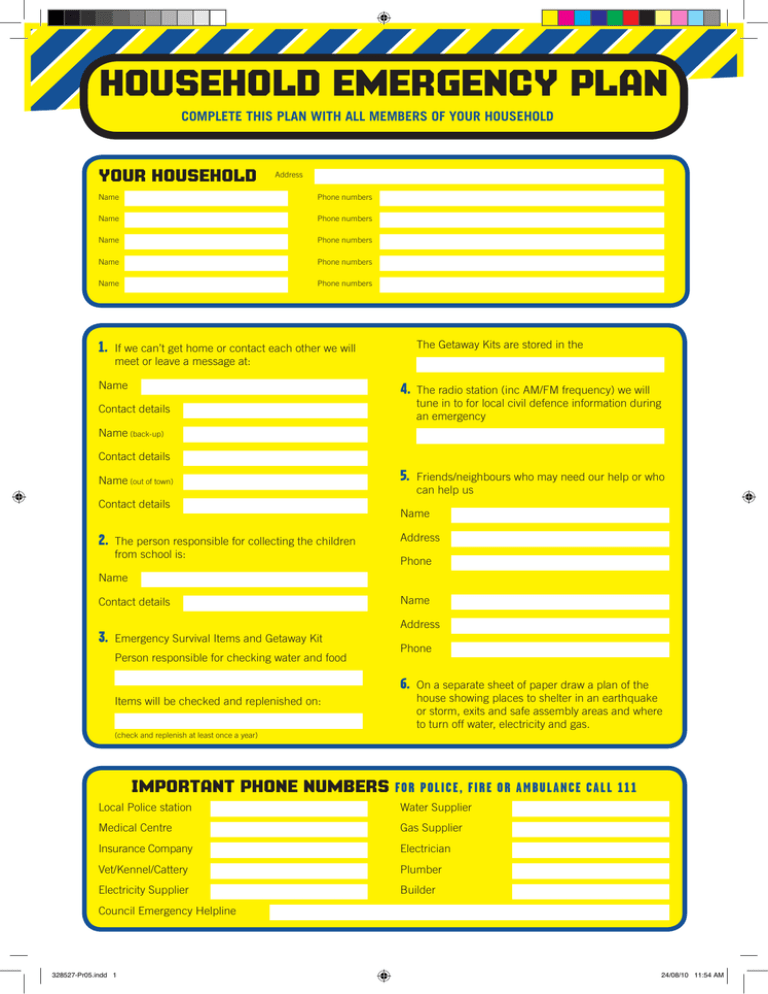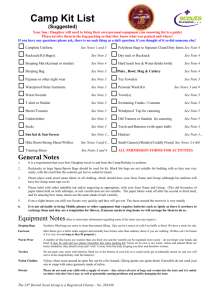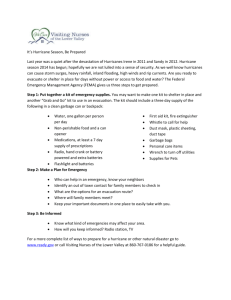HOUSEHOLD EMERgEncy PLAn
advertisement

HOUSEHOLD EMERgency PLAN Complete this plan with all members of your household YOur household Address Name Phone numbers Name Phone numbers Name Phone numbers Name Phone numbers Name Phone numbers The Getaway Kits are stored in the 1. If we can’t get home or contact each other we will meet or leave a message at: Name 4. The radio station (inc AM/FM frequency) we will tune in to for local civil defence information during an emergency Contact details Name (back-up) Contact details Name (out of town) Contact details 2. The person responsible for collecting the children from school is: Name Contact details 3. Emergency Survival Items and Getaway Kit Person responsible for checking water and food 5. Friends/neighbours who may need our help or who can help us Name Address Phone Name Address Phone 6. On a separate sheet of paper draw a plan of the house showing places to shelter in an earthquake or storm, exits and safe assembly areas and where to turn off water, electricity and gas. Items will be checked and replenished on: (check and replenish at least once a year) Important phone numbers For Police, Fire or Ambulance c all 111 Local Police station Water Supplier Medical Centre Gas Supplier Insurance Company Electrician Plumber Vet/Kennel/Cattery Electricity Supplier Builder Council Emergency Helpline 328527-Pr05.indd 1 24/08/10 11:54 AM HOUSEHOLD EMERgency checklist get you ready so need you can getthrough thru what will to get EMERGENCY SURVIVAL ITEMS Torch with spare batteries or a self-charging torch Radio with spare batteries Wind and waterproof clothing, sun hats, and strong outdoor shoes First aid kit and essential medicines Blankets or sleeping bags Pet supplies Emergency toilet - toilet paper and large rubbish bags Face and dust masks Check all batteries every 3 months. GE TAWAY KITS Everyone in the house should have a packed getaway kit in an easily accessible place which includes: Torch and radio with spare batteries Hearing aids and spare batteries, glasses or mobility aids Emergency water and easy-to-carry food rations Extra supplies of special dietary items First aid kit and essential medicines For infants or young children – formula and food, nappies Change of clothes (wind/waterproof clothing and strong outdoor shoes) Toiletries – towel, soap, toothbrush, sanitary items, toilet paper Food and water for 3 days or more Blankets or sleeping bags Non-perishable food (canned or dried food) Face and dust masks Food, formula and drinks for babies and small children Pet supplies Water (at least 3 litres per person, per day) for drinking Water for washing and cooking A primus or gas barbeque to cook on A can opener Consider stocking a two-week supply of food and water for prolonged emergencies such as a pandemic. Check and replace food and water every twelve months. How to store water • Wash bottles thoroughly in hot water. Fill each bottle with tap water until it overflows. Add five drops of household bleach per litre of water (or half a teaspoon for 10 litres) Important documents: Identification (birth and marriage certificates/driver’s licences and passports Financial ( insurance policies and mortgage) precious family photos If we have to evacuate we will: Take our Getaway Kit Turn off electricity and water Turn off gas only if we suspect a leak or if asked to do so by the authorities Take our pets with us • Store in a cool dark place and replace the water every 12 months For more information visit the Civil Defence Emergency Management Of fice at your nearest council or www.getthru.govt.nz PRODUCED BY THE MINISTRY OF CIVIL DEFENCE and EMERGENCY MANAgement 328527-Pr05.indd 2 24/08/10 11:54 AM

